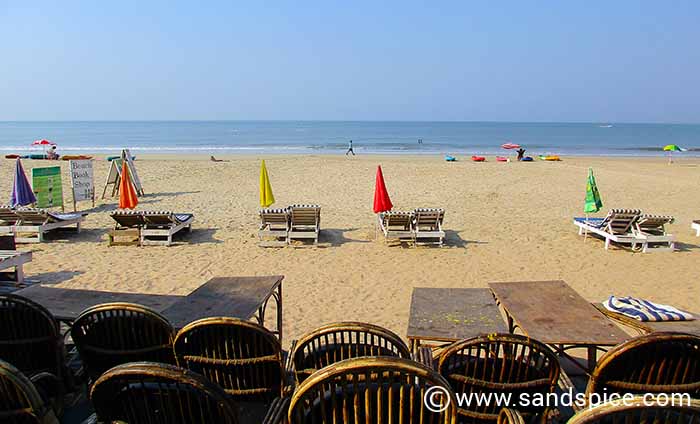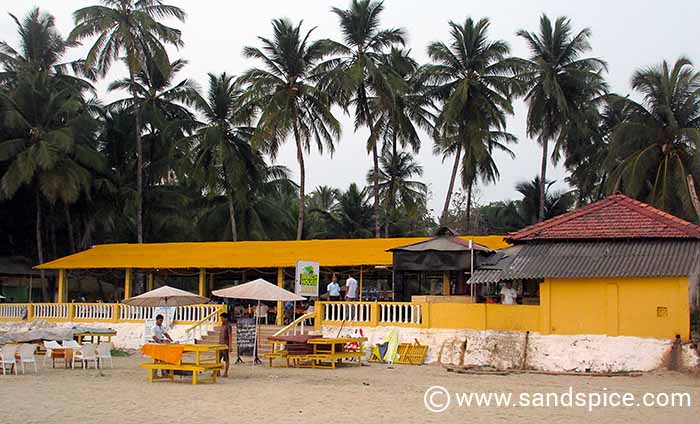
Palolem Beach Guesthouses 🏖️ Where to stay in South Goa, India
We never set out to become self-proclaimed experts on the beach guesthouses of Palolem. We just wanted a quiet little break. Instead, we were served up a masterclass in the art of making the best of a bad situation. A cancelled train here, a dodgy booking there, and suddenly, we were living a real-time, real-life travel show, hopping from one wooden shack to the next with all the frantic energy of a confused tourist.
What started as a minor inconvenience, a frustrating little hiccup in our carefully planned Indian itinerary, turned into a 10-day residency. We found ourselves immersed in the peculiar world of South Goa’s temporary structures. It became a bit of an accidental experiment in endurance and adaptability, and honestly, we wouldn’t trade it for anything. It turns out that getting a bit lost is often the best way to find a story.
Highlights
- Palolem’s Peculiar Lodgings
- A House of Cards ♦️♠️♥️♣️
- Mini-Tour of Palolem’s Guesthouses
- In the Footsteps of Jason Bourne 🕵️
- Get to Goa from Mumbai
- Our Complete India Itinerary
- Accessories for the Tropics
- All Guesthouse Deals in Palolem
- Our Related India Articles
Palolem’s Peculiar Lodgings: Location & …Location
Palolem is a picturesque beach located in the Canacona region of South Goa, India. Known for its clear blue waters and white sandy beaches, it is a popular destination for tourists looking for a relaxing getaway.
The whole of Palolem feels like a place built on a dare. We’re talking about a seaside village that appears and disappears with the seasons.
We first noticed it when we saw the wooden planks with numbers scrawled on them, stacked neatly in piles. Then someone explained it to us: every year, these places—the restaurants, the bars, the guesthouses—are completely dismantled, only to be resurrected a few months later. It’s a bit like a magic trick, but with more splinters and a distinct lack of top hats and Paul Daniels.
The vast majority of cabins on Palolem beach are not, despite their proximity, on the beach. They’re tucked away in a second row, a sort of ‘lesser’ tier of accommodation, where the sea breeze is but a fond memory. You can stand on the beach and squint, but you’ll not get a sea view.
For one of these cabins, we were asked to pay around 1,500 rupees (€20). It’s a sum that feels perfectly reasonable until we realised we can get a sea view for just a little more.

Palolem Beach Guesthouses – Sea view
For a cabin on the beach, the price can jump to 2,000 or even 3,000 rupees (€27), though with the right timing and a bit of good-humoured haggling, we managed to get one for as little as 1,800 rupees.
The moral of the story? Always negotiate, but don’t be a pain about it.
 All Guesthouse Deals in Palolem
All Guesthouse Deals in Palolem
A House of Cards ♦️♠️♥️♣️ The Perils of Temporary Buildings
These places are all temporary seasonal structures, a government requirement to protect against the monsoon season. We saw the numbers on the planks, a peculiar sort of building blueprint laid bare for all to see.
We were told it takes about a month to take everything down and another two months to put it back up. This is done by contractors who, we were told, are not known for their gentle touch. This explains the broken bits, the slightly-off angles, and the general air of ‘built in a hurry’ that pervades every cabin.
It’s an interesting business model, isn’t it? We build a whole village just to tear it down again six months later. It makes us wonder what sort of existential crisis the local builders have around November. “Right, that’s it then. See you next year, old plank number 42.”
This impermanence, this frantic push to make money while the sun shines, is something you have to bear in mind when you’re haggling. They’ve only got a short window to make a living, so you can be firm, but you should also be fair.
Our Mini Tour of Palolem’s Guesthouses
During our 10-day break, we stayed in four different guesthouses. It became a bit of a personal quest to find the perfect mix of price, location, and not having a tree growing through the bedroom. Here’s how we got on:
Abel Cressida: The Treehouse Experiment
Abel Cressida was our first stop. We’d been on the road for a while, we were tired, and it looked good enough.
We paid a mere 800 rupees for a garden cabin, and it was… an experience. The cabin was in a pleasant garden setting, which sounds lovely – and it was, until we noticed the tree. A very large, very rooted tree growing directly through the middle of the room. We found this fascinating and a bit unhelpful.
There was a single nail in the tree, which we promptly used for our one and only hanging item.
The bathroom was equally utilitarian. Of the two taps, one offered a constant drip and the other nothing at all. We could have lived with this, but the real deal-breaker was the sheer lack of space. We couldn’t unpack our bags. We had a small table and the floor, and that was it.
So we decided it was a one-night-only situation. The food, on the other hand, was good and reasonably priced.
You can also organize boat trips from here to various destinations including Monkey Island and Butterfly Beach.
Brendan’s: The Sensory Overload Suite
After our brief foray into rustic treehouse living, Brendan’s felt like the epitome of luxury.
We managed to negotiate an AC beach cabin for 1,800 rupees, down from 3,000. It had a peripheral sea view, a TV we didn’t touch, and a fridge that we absolutely did. We used that fridge for a full 48 hours to chill our drinks, and we were honestly never happier.
The cabin was clean and had a decent mosquito net and a solid bed.
We thought we’d won. Then came the evening.
Our cabin was located directly above the kitchen preparation area, and the floorboards had wide gaps in them. We could literally watch the staff peeling potatoes and preparing dinner.
Every night from 10 pm until midnight, a symphony of clanging pots, scrubbing dishes, and high-pitched arguing staff members filled our room.
We didn’t get a lot of sleep.
Having said that, the food and drink here were very good and reasonably priced. We also made good use of the free beach beds and towels. They also offered free WIFI, but the performance was excruciatingly slow and erratic, punctuated by frequent power cuts.
They showed sports on a big screen in the evenings, which was not our cup of tea, but it seemed to go down well with the locals (Indian cricket- and some European football). We spent two nights here and made good use of the fridge to store and prepare our gin and tonics with fresh limes. Our private balcony area was a welcome slice of peace.
Neptune Point: The Semi-Detached Squeeze
Neptune Point was the only place we had booked in advance.
For our €20 (1,500 rupees), we got a decent-enough semi-detached cabin behind the resort.
It was… fine.
Back there, the sea breeze was a distant memory. The evenings were a bit stuffy, and our neighbours were uncomfortably close. We could hear every whispered conversation and feel every footstep as if they were in our room.
These lightweight cabins have no concept of personal boundaries.
We stayed at Neptune Point for three nights. The food and service were solid, but we couldn’t shake the feeling that we were living in a shoebox with a shared wall. They offered us a detached cabin, but for a price of 3,000 rupees and no sea view, we respectfully declined.
It was the sort of place that was perfectly adequate but lacked any real sense of charm. We needed to move on.
Havana Cuba: The High Life We Finally Found
Havana Cuba was our final stop. Our last chance to find a bit of sanity.
We managed to get an elevated, first-floor, sea-front cabin for 1,900 rupees, which felt like a win. For this price, we had to agree to a four-night stay, but we were so tired of moving that we didn’t even flinch.
The cabin had a steady sea breeze, a decent-sized (if lumpy) double bed with a proper mosquito net, and plenty of storage.
The bathroom had a hot and cold shower with good pressure, which was a genuine luxury after the dripping tap at Abel Cressida.
The best part? The large balcony, with its hammocks and the most glorious views of the entire beach. We could see from one end to the other, a proper King and Queen of the castle moment.
The attached restaurant served a standard but solid variety of Goan dishes, and we were happy to eat there. The place also had six CCTV cameras and security guards, which felt a bit like overkill, but we weren’t going to complain about feeling safe.
As with the other places, they provided free beach beds, towels, and umbrellas, and the WIFI was as spotty as ever. We found a couple of internet cafes a few minutes behind the beach when we needed to do something serious, and it only cost us 30 rupees for half an hour.
After 10 days of trial and error, we felt we’d hit the jackpot.
Moving on to Mumbai
We were sorry to leave. Palolem, and especially our little spot at Havana Cuba, had become our home. It offered a kind of relaxed lifestyle that is incredibly easy to get used to. We had settled into a routine of long walks, lazy afternoons, and an endless supply of fresh lime sodas.
The next destination on our Indian itinerary was about to present us with the polar opposite of Palolem beach. We were about to embrace the frenzied metropolis that is Mumbai, a stark contrast to our little beach shack.
We were ready for it, but not before one last hammock session. 😎
If you enjoyed Palolem Beach Guesthouses, check out India West Coast – Kerala to Goa. You may also like:
Spice up your inbox…

… with discounted hotel deals, cost-saving travel itineraries and SandSpice escapades! 😉



















































